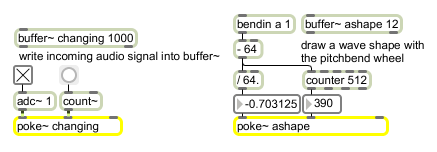Examples

Write into a buffer~ using either signals or numbers
Write sample values to a buffer by index
| Name | Type | Opt | Description |
|---|---|---|---|
| buffer-object-name | symbol | Obligatory. Names the buffer~ where poke~ will write its incoming samples. | |
| channel-number | int | opt | Sets the channel number of a multichannel buffer~ where the samples will be written. The default channel is 1. |
| int | value/sample-index [int] |
In left inlet: Converted to float. In middle inlet: Sets the sample index for writing subsequent sample values coming in the left inlet. If there is a signal connected to this inlet, a float is ignored. |
| (inlet2) | channel-number [int] |
In right inlet: Sets the channel of the buffer~ where sample values are written. The first (left) channel is specified as 1. |
| float | value/sample-index/channel-number [float] |
Like the peek~ object, poke~ can write float values into a buffer~. Note, however, that the left two inlets are reversed on the poke~ object compared to the peek~ object. In left inlet: Sets the value to be written into the buffer~ at the specified sample index. If the sample index is not , the value is written. In middle inlet: Converted to . In right inlet: Converted to . |
| list | value sample-index and channel-number [list] |
In left inlet: A list of two or more values will write the first value at the sample index specified by the second value. If a third value is present, it specifies the audio channel within the buffer~ for writing the sample value. |
| (mouse) | Double-clicking on poke~ opens an editing window where you can view the contents of its associated buffer~ object. | |
| set | buffer-object-name [symbol] |
The word , followed by the name of a buffer~, changes the buffer~ where poke~ will write its incoming samples. |
| signal | In left inlet: Signal values you want to write into a buffer~. In middle inlet: The sample index where values from the signal in the left inlet will be written. If the signal coming into the middle inlet has a value of -1, no samples are written. |
